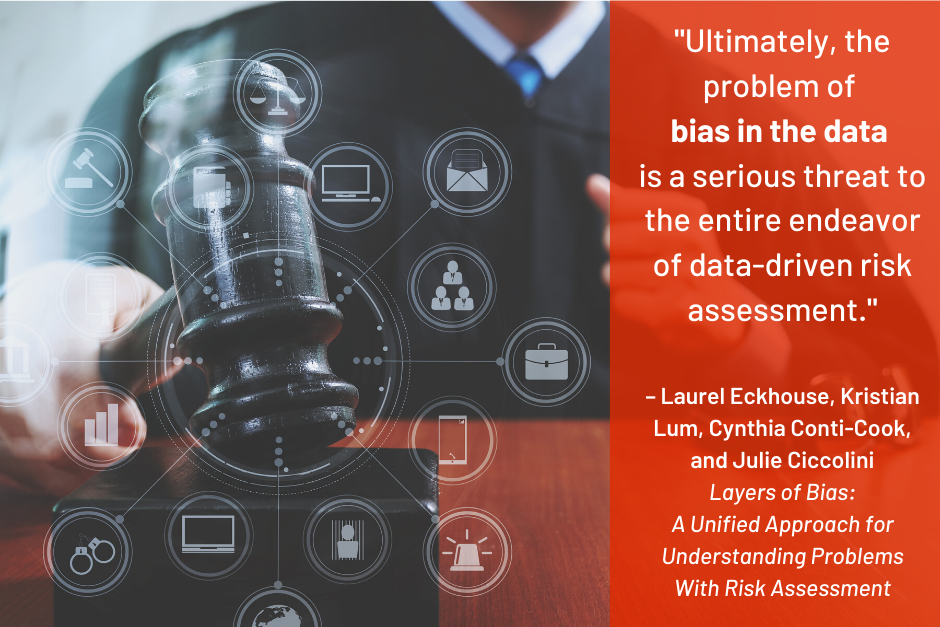Regardless of their science, brand, or age, these tools are derived from data reflecting structural racism and institutional inequity that impact our court and law enforcement policies and practices. Use of that data then deepens the inequity.
Pretrial Justice Institute1Pretrial Justice Institute: Updated Position on Pretrial Risk Assessment Tools (2020)
Most pretrial RATs use elements of someone’s criminal legal history in their calculation of risk. These elements include previous convictions, arrests, type of charge, if charges are violent, previous sentences, and failures to appear in court.
These criminal history-based variables may appear “objective” in determining risk.
However, as detailed in the following subsections, using past arrests, convictions, failures to appear, and the current charge as measurements for future risk draws upon a history of racial and class bias in the criminal legal system.
The U.S. has a long history of racial profiling and racial and class bias in arrest, convictions, and sentencing.2Ashley Nellis: Still Life: America’s Increasing Use of Life and Long-Term Sentences, The Sentencing Project3The Sentencing Project: Report of The Sentencing Project to the United Nations Special Rapporteur on Contemporary Forms of Racism, Racial Discrimination, Xenophobia, and Related Intolerance: Regarding Racial Disparities in the United States Criminal Justice System
The “objective” factors that tools pull in from criminal legal system data are inputs that emerge from past decisions made by police, prosecutors, and courts about an individual. They are all impacted by systemic injustice.
As Kay Whitlock and Nancy Heitzeg put it:4Kay Whitlock and Nancy A. Heitzeg: Billionaire-Funded Criminal Justice Reform Actually Expands Carceral System, Truthout “Are assessment tools harmless? In purporting to reduce “bias” in pre-trial outcomes, the data they use still rely primarily on information about a person’s prior encounters with police and the courts. The unspoken assumption is that all of those “encounters” are untainted by racism or other structural factors that predetermine who is most likely to be presumptively criminalized. This, in turn, legitimates the structural violence of policing.”
Studies have also shown racial disparities in all aspects of the criminal legal system, from pretrial detention through probation. One San Francisco study found that racial disparities worked against all non-white racial groups, especially Black individuals: Black people were less likely to have charges dropped, received longer sentences of incarceration, were more likely to be arrested for a felony, and were more likely to be detained pretrial.5John MacDonald and Steven Raphael: An Analysis of Racial and Ethnic Disparities in Case Dispositions and Sentencing Outcomes for Criminal Cases Presented to and Processed by the Office of the San Francisco District Attorney, University of Pennsylvania Department of Criminology and University of California, Berkeley Goldman School of Public Policy
This means algorithms that are created using criminal history data from the past few decades are trained on biased data, even if they do not explicitly use race or income as inputs.
Police, prosecutors, and courts define and collect these data points, simplifying the complexity of a person’s experience in the criminal legal system down to a tally of prior arrests and convictions without individual, humanizing context.
Based on our research, 95% of the jurisdictions in our database include prior arrests, current charges, or pending charges in their calculation of predicted risk — metrics that count against someone even though they are legally innocent.
Because there is no way to actually measure every single single act of harm in our communities and not all crimes are reported, RATs use proxies of arrest and conviction to predict risk of rearrest,6Partnership on AI: Report on Algorithmic Risk Assessment Tools in the US Criminal Justice System which, in and of itself, is a proxy for actual criminal activity. However, whether or not someone is arrested, convicted, pulled over, searched, or surveilled has a lot to do with their race and class.7Samantha Melamed: Philadelphia police are searching more cars for marijuana — but finding less of it, critics say, The Philadelphia Inquirer
This means that “arrest, conviction, and incarceration data are most appropriately viewed as measures of official response to criminal behavior,”8Delbert S. Elliot: Lies, Damn Lies and Arrest Statistics, Center for the Study and Prevention of Violence rather than criminalized behavior itself. The official responses to crime are heavily biased.
Using data from previous decades to create RATs means that the RAT algorithms fail to account for the changes in pretrial outcomes that more recent bail reforms have created. This leads to “zombie predictions” that overestimate risk and ignore changes and reforms in pretrial systems.9John Logan Koepke and David G. Robinson: Danger Ahead: Risk Assessment and the Future of Bail Reform, Washington Law Review
Acknowledging this bias in the criminal legal sphere does not even begin to address the history of social exclusion, lack of social supports, and disinvestment in communities that has heavily impacted these populations and their relationship with law enforcement.
Using criminal history data to predict risk is far more complex than assuming past “bad” behavior can predict future dangerousness.


